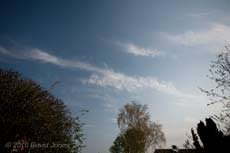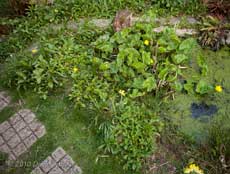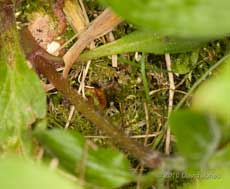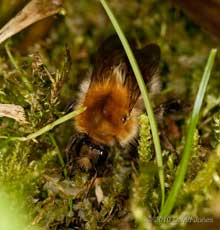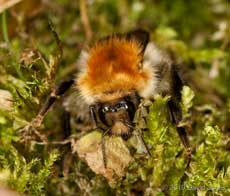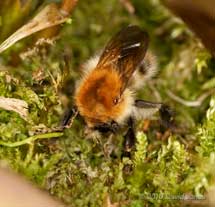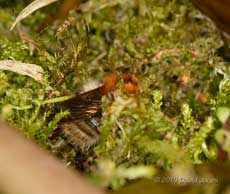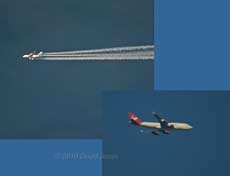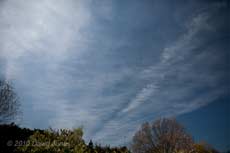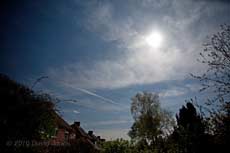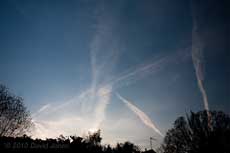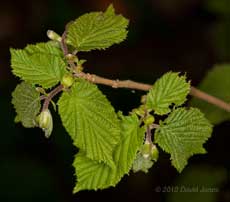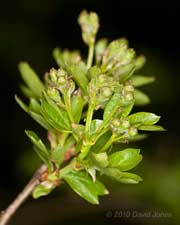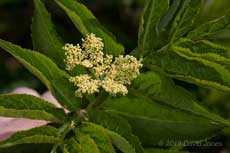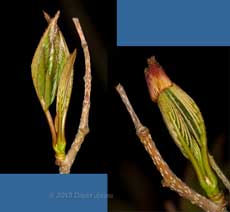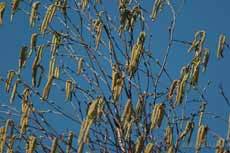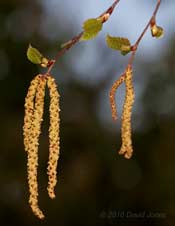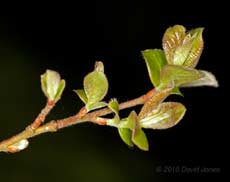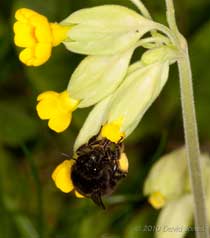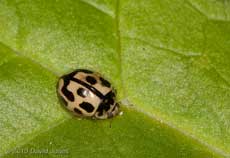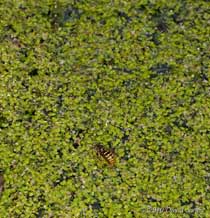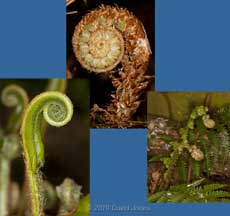Go to the last entry on this page .....Go to previous entry19 April - Another beautiful day, and still no contrails (though this state will not be fore much longer).
At 8.15pm it is mainly cloudy, with mid-level cumulus clouds despite the forecast suggesting a clear night!
I'm afraid that yesterday was one of those days which I have to cancel from time to time as I struggle to stay awake. However I must record my first sighting of House Martins this year. there was just a pair of birds, obviously together, which spent an hour or so in the area, mainly over the Brickfields Country Park, before disappearing again. I didn't see them today so perhaps they have moved on. In my last entry I mentioned the Common Carder Bumblebee (Bombus pascuorum) that seemed to be setting up 'home' in the moss of our big pond. When it was there again yesterday and today I spent quite a while watching it at work.
The area that it has chosen is at one end of the big pond. Once just water, I have allowed vegetation to reclaim the area so that it is now up to around 8cm above water level, but still very wet. The surface is covered with moss and has a canopy of large Marsh Marigold foliage. It s in the moss of this raised platform that the Carder Bumble has made nests several times since the pond was installed.
This time I have been fortunate enough to see the queen's behaviour right at the beginning of the process, and it was fascinating to watch.
It seems that the spot chosen for the nest is right at the side of the pond. However, the approach to this is via a covered walkway with a small opening though which it is occasionally to see the bumblebee as she goes to or from the nest (at bottom of picture). Yesterday she was still working on this area and while I kneeled down to watch I could hear her tearing at the moss!
In the other direction, the walkway becomes a path that leads most of the way around a Marigold plant and for much of the day she was active along its whole length. As she headed away from the nest she was hidden from sight for much of the path , but towards the end of it she was exposed enough for me to watch from a perch on a plank placed as a bridge across the end of the pond.
From this vantage point I watched as she arrived and started work on the moss at the end of the path. (after this visit I snipped off the blades of grass seen in this picture)
On her arrival she immediately started biting off fronds of moss,
and pushed them under her body to behind her. She did this for a short time before turning around and heading back along the path to the nest where I would see her passing the opening on her way in. Unfortunately, once she turned away from me it wasn't possible to see if she was carrying any moss. That is something I need to watch for on another day.
However, as she headed back out again it became obvious that as she moved along the path she was constantly passing moss back behind her.
As the morning went, on the path was being extended further around the Marigold. In this picture we catch a glimpse of her banded abdomen.
Occasionally she would take a break from this work, flying off to feed (and collect pollen?). On one occasion, before leaving the garden she flew to some violets that hangover the water of the small pond, and nearly ended up in that water as the flower stalks bent under her weight! I have a copy of 'Bumblebees' by Ted Benton, and it's interesting to read in that in 1866 William Edward Shuckard described how workers bit off filaments of moss, formed them into pellets and passed them back along chains of workers to the nest. I wonder if I will have the opportunity watch similar behaviour as this nest develops. I guess that what I saw today was a precursor to that behaviour, with the queen having to do it all herself!
21 April - The dry, bright weather continues, albeit with it quite cool, especially in the mornings, but -
With UK airspace being opened up to commercial flights yesterday evening we have seen the last of skies 'decorated' only by natural cloud formations, for a while. Here, a jet heads west at high altitude while a Virgin Atlantic jumbo jet from Miami makes its final approach to Heathrow, possibly delivering some very relieved passengers back to the UK.
While the sky in those first two pictures seems clear, it only needs a broader view to see the different that the vapour trails (contrails) make as they are spread by high level winds. This first view is looking just west of north,
and this is to the south. Just about every cloud seen in both pictures has developed from contrails. Compare this picture with the one at the top of the page, taken on the 19th.
I've taken down the two white surfaces that have been left on top of the caravan shelter for the last five days and brushed the surface dust into a petri dish. It's obvious from the yellow colour that predominates that most of it is pollen, probably from trees like our Birch which is in full flower at the moment. However, there are lots of dark specks as well as some green and blue specks which I suspect are from polythene tarpaulins (or similar) that have rotted away thanks to UV light. I will need to get out my microscope to take a much closer look, but not at the moment, I'm afraid). Family matters have kept me from the garden for much of the last two days, but I can confirm that the Carder Bumble bee is continuing work on its nest.
23 April - Another cloudless day, apart from the high veil of dissipating vapour trails.
In this picture taken this evening, not even the blue areas are anything like clear.
As well as seeing a pair of House Martins and a trio of high flying Swifts (see the nest box diary), I also saw my first Buzzard of the year.
Down in the garden things are turning greener by the day, and that includes the trees. I've been amiss this Spring in that I have missed several 'first leaves' events, so that trees like the two small Hazels (next to the Ivy tree) are well into leaf now.
The Hawthorn now has quite a few small leaves, and its flower buds are obvious, especially on the south facing side (my neighbour's garden).
Next to the Hawthorn, the Elder's leaves are large, having been out for a while, and there are a number of flower inflorescences, although are still small buds at the moment.
Beyond the big pond, the Rowan is only just unfurling its leaves which have been developing encased in red buds, retained as a red cap in the left hand picture. As yet there is no sight of any flower buds. Last year was a disappointing one, with the Rowan failing to produce any berries, due mainly to the poor weather (I think).
In a dramatic contrast, the Himalayan Birch has been decked in catkins for the last week or so,
and it is only today that I've seen the first leaves making their appearance.
One last tree to mention is our Willow, grown from a seedling in a large tub buried in the ground on the south side of the big pond. Each year I prune it so that it doesn't grow much higher than the shrubs along that part of the garden perimeter - it is now around 6ft tall. Its leaves are small and quite furry at the moment.
Over the last two days I have not seen the Carder Bumblebee. However, I'm pretty certain that all is well, as every time I check the entrance to the nest the moss appears to have been disturbed. On the weekend I may set up a wireless cctv camera to monitor the spot.
I was also wondering what had happened to the small black bumblebee. I had not seen it despite the sunshine, but late this afternoon, when most of the garden was in shade, it (or at least a bee of the same type) turned up to feed at the Cowslips. Here you can see its long proboscis reaching up into the bell of the flower. I have still to identify the species.
I can add one more species to the ladybirds seen so far this year. This rather pink tinged 14-spot Ladybird was wandering over a Marsh Marigold leaf.
Over the last three days I've started to notice wasps in the garden for the first time this Spring, and the usual place to spot them is over or on the big pond, or rather, on the duckweed as they collect water which is taken back to the nest. On this occasion the camera wasn't equipped for close-ups! I have not yet spotted any wasps scraping at wood to collect the fibres needed to produce the paper of their nests.
And finally, back to a group of plants that excel in the shade offered by the shrubs and fencing on the south side of the garden - the ferns. We have a number of long established ferns that hardly get a mention in these diaries, and that is something I should find time to remedy. In the meantime, some are now unfurling this year's fresh fronds, while many of the old ones lie draped over the ground.
Click on images to see larger version |
|
